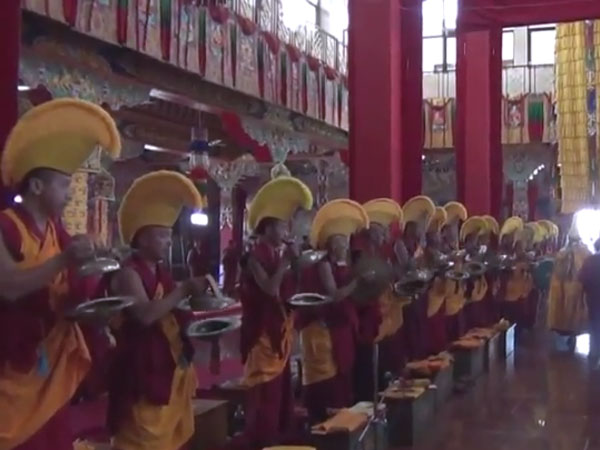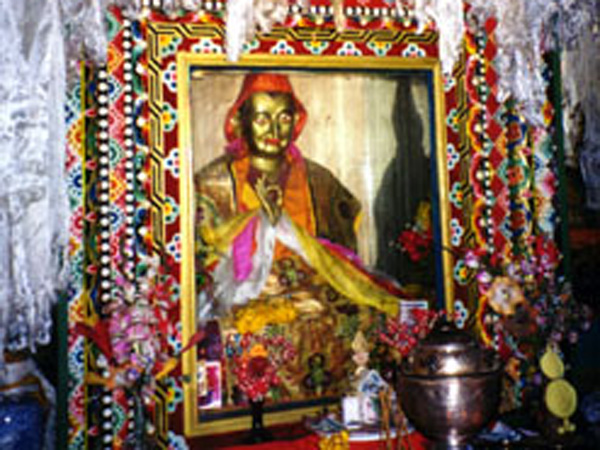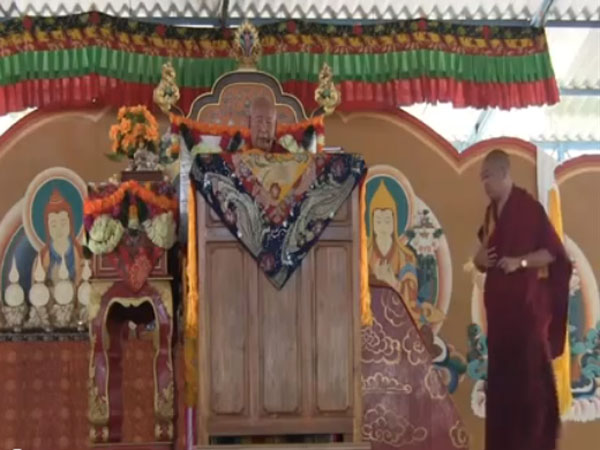DHARMA READINGS
| DORJE SHUGDEN ON BLACK HORSE | | Print | |
 by Brunhild Hekate
Readers' Comments
A History of Dorje Shugden in the Sakya TraditionThe Sakya lineage holders are emanations of Avalokiteshvara and Manjushri and their family lineage is famously divine. Practices within the Sakya lineage are passed down from father to the eldest son, ensuring the continuity of the lineage across generations, pure and accurate. Similarly, the practice of Dorje Shugden has been passed down within the Sakya lineage for several generations until recently, when the practice lost its popularity due to political expediency.
Morchen Kunga LhundrubHistorically, the Sakya School of Tibetan Buddhism has viewed Dorje Shugden as an enlightened being. Dorje Shugden was first practised by the Sakyas in the early 17th century, beginning with the Sakya Kangsol written by Morchen Kunga Lhundrub (1654–1728), who was Sakya’s most precious Tantric and Lamdre Lineage holder. He wrote praises to Dorje Shugden as an enlightened being, and composed some of the earliest descriptions of the iconography and activities of Dorje Shugden and his four cardinal emanations. Morchen Kunga Lhundrub was also the first to describe Dorje Shugden as being seated on a lion throne. Prior to this, the Sakya Kangsol refers to Dorje Shugden as Dorje Shugden Tanag, or Dorje Shugden Riding a Black Horse, one of the forms of Dorje Shugden unique to the Sakyas. Paintings, thangkas and murals of Dorje Shugden Tanag were found in Sakya Monastery located in Tsang, Tibet before the turn of the 20th century. 
Main temple of Sakya, Lhakang Chenmo 
Northern Sakya Seat, Tibet 
Southern Sakya Seat, Tibet
The 30th Sakya Throneholder Sonam RinchenDorje Shugden was inducted into the pantheon of Sakya protectors by the 30th Sakya Trizin Sonam Rinchen (1705-1741), who strongly propitiated the form of Dorje Shugden riding a black horse. Sonam Rinchen later placed Dorje Shugden together with two other Protectors, Dorje Setrab and Tsiu Marpo, and these three principle protectors were collectively known as the “Three Kings” (Gyalpo Sum). 
Dorje Shugden, one of the Three Kings, is part of the Sakya pantheon of Dharma Protectors
The 31st Sakya Throneholder Sachen Kunga Lodro
Sakya Kunga Lodro Sachen Kunga Lodro (1729–1783), a great master of the Sakya tradition and the 31st Sakya Trizin, is believed to have been an incarnation of the great Sakya Pandit, Buton Rinchen Drub and Shakya Shri, a Kashmiri Pandit in the line of Sakya masters of Dorje Shugden’s lineage. One of Shakya Shri’s predecessors, an Indian master named Jetari, was also Atisha Dipamkara’s guru. Sachen Kunga Lodro received all the transmissions of Dorje Shugden, amongst others, from his father, Sonam Rinchen, and it was he who fully culminated the various rituals of Dorje Shugden, combining the lineages received from his father with those of Morchen Kunga Lhundrub. Sachen Kunga Lodro clearly carried on the tradition of his father, praising Dorje Shugden as an enlightened protector. Sachen Kunga Lodro also wrote a wrathful torma offering to Dorje Shugden called ‘Swirl of Perfect Sense Offerings‘. This ritual was later used by Kyabje Pabongka Rinpoche as part of his ‘Melodious Drum Victorious In All Directions‘, one of the most well-known rituals to Dorje Shugden. Thus, the source of some modern-day Dorje Shugden practices can be traced to the Sakya school. The text written by Kunga Lodro has also been included in the latest edition of the Dorje Shugden bebum, published by Lama Gangchen Rinpoche. 
The 32nd Sakya Trizin Wangdu Nyingpo (1763–1809) depicted in this 19th century thangka, with Dharmapala Chitipati (left) and Dharmapala Dorje Shugden (right) 
A close up of Dorje Shugden Tanag 
The complete thangka. At the top are the principal meditational deities special to Wangdu Nyingpo – Chakrasamvara, Vajrayogini and Hevajra at the upper left and Vajrakila, Hayagriva and Vajrapani at the upper right. To the left is Chitipati, the two dancing skeletons, and to the right is Dorje Shugden Tanag, riding a black horse. Below him is Panjarnata Mahakala with Brahmarupa Mahakala on the left and Shri Devi Dudsolma on the right
The 37th Sakya Throneholder Kunga Nyingpo
A close up of the 33rd Sachen Kunga Lodro would later go on to fulfil the prophecy of Mahasiddha Pema Dudul, who said in response to the 35th Sakya Throneholder Tashi Rinchen’s question about his future heir:
By this cryptic statement, Mahasiddha Pema Dudul meant that his grandfather, the great 31st Sakya Trizin Sachen Kunga Lodro, would eventually take rebirth as the son of the 35th Sakya Trizin Tashi Rinchen, thus upholding the most esoteric and precious Sakya teachings to benefit living beings. In 1850, Sachen Kunga Lodro was indeed reincarnated as Kunga Nyingpo, who went on to ascend the Sakya Throne in 1883 as the 37th Sakya Trizin. 
A 19th century Sakya thangka depicting the Five Emanations of Dorje Shugden. At the bottom left is the grandson of Kunga Lodro, the 33rd Sakya Throneholder Pema Dudul (1792–1853) . This form of an enthroned Dorje Shugden is similar to another thangka in Trode Khangsar
The 39th Sakya Throneholder Dragshul Trinley RinchenDragshul Trinley Rinchen, the 39th Sakya Trizin explained in his autobiography that his father, the great Sakyapa Kunga Nyingpo was one with Avalokiteshvara. To prove this, he recounted the story of Mahasiddha Pema Dudul and Tashi Rinchen mentioned above. He then wrote:
As can be seen throughout his autobiography, Dragshul Trinley Rinchen was also a staunch Dorje Shugden practitioner, with many rituals and offerings to Dorje Shugden recorded in great detail. His autobiography also notes the occasions when he met Dorje Shugden through an oracle, and it was during one such occasion that Dorje Shugden reminded Dragshul Trinley Rinchen to uphold the Dharma in general and gave some prophecies. Dragshul Trinley Rinchen was a great Sakya master, and is considered one of the most outstanding lineage masters of our time.
The 40th Sakya Throneholder Ngawang Thutob WangchukThe 40th Sakya Trizin Ngawang Thutob Wangchuk was born as the heir-apparent to Dragshul Thrinley Rinchen. The biography of the 41st Sakya Trizin names Ngawang Thutob Wangchuk as an emanation of Avalokiteshvara who has the ability to see and speak to Manjushri. As demonstrated on one occasion, the famous and holy Manjushri statue called Jamyang Tsodgyalma did speak to him, instructing him to practise the Guru Yoga of his father (instead of reciting confession prayers) while contemplating the ultimate view, thus merging his mind and the primordial wisdom of his father into one. 
The Sakya Lineage Thus, one can see clearly that Dorje Shugden Tanag has been an important and integral practice of the Sakya Tradition for the past few hundred years. Furthermore, the line of Sakya Throneholders has viewed Dorje Shugden as a fully enlightened being who is one with Avalokiteshvara and Manjushri. However, since the early 20th century, the Dorje Shugden Tanag practice has gradually declined. 
H.H. Jigdal Dagchen Sakya (b. 1929) The offering rituals for the Three Kings are no longer found in the standard Sakya Protector manuals of Indian and Tibetan monasteries. Neither can paintings or murals of Dorje Shugden Tanag be found in Sakya monasteries. Today, there are still a few enlightened masters who continue to be bastions of Dorje Shugden’s practice in the Sakya school. One is the Abbot of Ngor monastary, an important branch of the Sakyapas. Another is H.H. Jigdal Dagchen Sakya, the current head of the Phuntsog Phodrang who lives in Seattle, Washington with his descendants. H.H. Dagchen Rinpoche is the twenty-sixth generation of the Sakya-Khon lineage, and is regarded as an embodiment of Manjushri. He is in line to be the 42nd Sakya Trizin, which means that the lineage of Dorje Shugden Tanag may rise to prominence once again. After all, some of the Sakya Trizins are, without a doubt, emanations of Dorje Shugden! 
Thartse Jampa Namka Chime, the abbot of Ngor monastary in the late 18th century and the previous incarnation of Jamyang Kyentse Wangpo
An Overview of the Sakya Trizin Line from the 30th to the 40th Throneholders

His Holiness the 41st Sakya Trizin
Special Mention to the Following Great MastersShakya Shri Bhadra
Shakya Shri Bhadra b.1127 – d.1225 Shakya Shri Bhadra (Shakya Shri) was a Kashmiri paṇḍit who was invited to Tibet by Tropu Lotsāwa Rinchen Sengge. He arrived in 1204, at the age of either fifty-nine or seventy-eight, and remained for ten years, leaving in 1214. Active primarily in Tsang, his significance to Tibetan Buddhism is characterized by his initiating four important lineages of teachings: to Sakya Paṇḍita he taught exoteric philosophy; pith instructions to Tropu Lotsāwa; tantra to Chel Lotsāwa; and Vinaya to Tsang Sowa Sonam Dze. Shakya Shri was born in Daśobharā, in Kashmir, in 1127 (or 1145). During the earlier stages of his time in Tibet, possibly while still en route to Tropu from Chumik in 1204, he met Sakya Paṇḍita Kunga Gyeltsen, who was on his way to Kyangdur with funeral offerings following the death of his father, Pelchen Opo. Shakya Shri is said to have given him teachings on logic at the time. During the 1208 summer retreat at Gyangong, he met Sakya Paṇḍita again and served as the upadhyaya in his ordination ceremony. During the 1210 summer retreat at Sakya, he gave Sakya Paṇḍita extensive teachings on Kalachakra, Vinaya, linguistics, poetry, logic and epistemology, and Abhidharma. The two worked on a retranslation of Dharmakirti’s Pramaṇavarttika. From this connection, Shakya Shri is often credited with initiating the tradition of logic in the Sakya school; while some dispute this characterization, his importance to the Sakya tradition was considerable. Kyabje Trijang Dorje Chang’s ‘Music Delighting an Ocean of Protectors’ also quotes Kyabje Ling Dorje Chang’s previous incarnation, Losang Lungtog Tenzin Trinley’s recognition of Shakya Shri as a previous incarnation of Dorje Shugden. The incarnation lineage is said to be as follows:
Atisha Dipamkara
Atisha Dipamkara b.982? – d.1054 The Bengali monk Atisha Dipamkara was of pivotal importance in the second transmission of Buddhism in Tibet. Invited from the Indian monastery-university of Vikramshila to Tibet by the Purang kings, Atisha spent thirteen years in Ngari and U-Tsang. He is credited with the propagation of the Lamrim and Lojong teachings that later became the core of the Geluk tradition; his composition, the Bodhipathapradipa is a central text for the Lamrim, or Stages of the Path. He was also instrumental in the spread of the cult of Tara in Tibet. Atisha’s main disciple Dromtonpa founded several important monasteries and gave rise to the Kadam tradition, which was later absorbed by the Gelug and, to some extent, the Sakya and Kagyu traditions.
Buton Rinchen Drub
Buton Rinchen Drub b.1290 – d.1364 Buton Rinchen Drub, a Sakya lama raised in a Nyingma family, was the eleventh abbot of Zhalu Monastery from 1320 to 1356. Some enumerations list him as the first abbot, as he significantly expanded the institution. He was an important teacher of the Prajnaparamita, a key lineage holder of the Guhyasamaja and Kalachakra tantras as transmitted in the Geluk tradition, and the Kalachakra, Hevajra and Sampuṭa tantras as transmitted in the Sakya tradition. He is generally credited as the creator of the Tibetan Buddhist canon, the Kangyur and Tengyur, and his History of Buddhism is still widely read. In addition to his Sakya training, he also studied in the Kadam and Kagyu traditions.
|
OTHER DHARMA READINGS
- A GUIDE TO SPIRITUAL PRACTICE
- DHARMA DEMYSTIFIED: NAGARJUNA, THE FOUNDER OF THE MAHAYANA TRADITION
- DORJE SHUGDEN ON BLACK HORSE
- WHY MANJUSHRI MATTERS
- DHARMA DEMYSTIFIED: THE ENTHRONEMENT OF DORJE SHUGDEN










